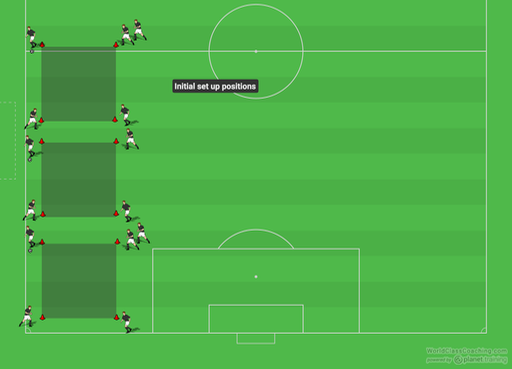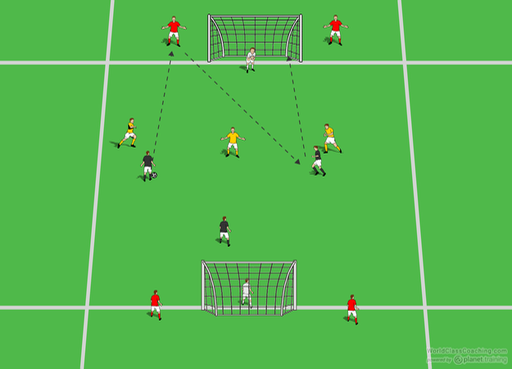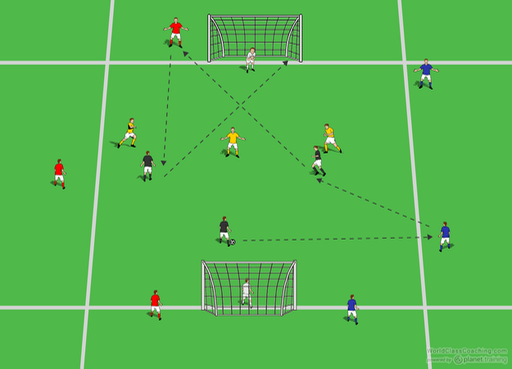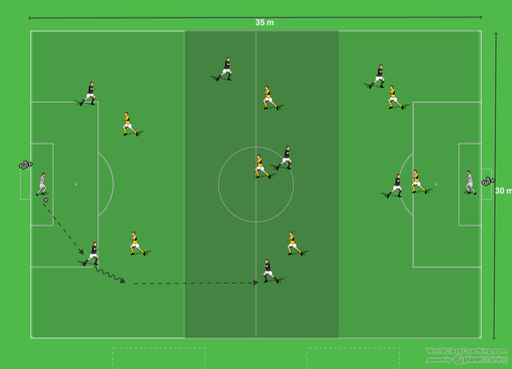By Steven Smith
This session is designed to support the following attacking principles:
Direct when possible
o Defined by longest ball forward that maintains possession or puts us in a better scoring opportunity. May be to the forward, may be over the top of defense may be to other players.
Preferences:
To the forwards feet
Down the same line from the OB to the OM/F with full team support and defensive balance
Counter attack when their defense is pushed forward (look to the cue) o Possession in the front third
Once we get the ball forward into the front third we don’t have to rush things. But when we do put the ball in the box we must have commitment and balance BOTH.
Counterattacking has three styles:
Ball sent long to a forward who goes to the goal (sometimes called lone attacker or solo counter attack). We want a different mindset. It may happen that our forward goes at them but if we have a total team response it may come from a second attacker.
Ball pressured in the front third due to the cue of the closest person to put pressure on the ball. Must be a total team response and we try to get a shot off within two to three passes. We will train this.
Ball cut out by our back and a series of total team transition with three to four passes to get a shot off.
Principles when attacking from possession:
Possession should happen mostly in middle to front third
When ball is in the middle portion of the field both 7 and 11 are wide
When ball is on flank, the near side 7 or 11 stays wide, the other has freedom
When ball is on flank with possession from OB I like two predictable balls.
• Down the flank and beyond defense then compress if don’t win
• To the CF who is not over checking
• To the DM who wants to restart or switch point
Activity 1: Dutch Squares Warm-up
Setup:
Three square grids are set up with 10 yard by 10 yard dimensions with barrier space between each grid. At least one person is placed on each cone and preferably at least one cone in each grid should have two players positioned.

Execution:
Passing occurs in various patterns as described in the diagrams. Each pattern is initiated by passing to the right first and after a determined time the initial pass goes to the left. Coaches must emphasize receiving the ball with the front foot on all activities that involve the ball moving forward. Back passes should be received with the back foot and the body turned sideways on. If there is an extra person on a cone, the extra should apply a little defensive pressure and the attacker should push the defender away with the body and slightly check toward the ball or hold the defender off.
Variations:
Add a second ball to the passing sequence.
For all passes, the players should look over their shoulder before receiving the pass.
For all passes, the passer must call out the pass with one of three terms:
• Back
• Turn
• Hold
Activity 2: 3 v 3 + 4 Target
Setup:
The teams are set up as shown with three black attackers vs. three yellow defenders. The four target players are at the end of the field but outside of the grid.

Execution:
Teams play three vs. three in the space with full sized goals and goal keepers at each end. The black team attacks the yellow team but can only score after hitting a target player on the end line who then must one touch it back into the field of play for the team inside the grid to score. Goals can only come after the one touch play from the end line players.
Variations:
Coach can restart every ball
Goal keeper can restart every ball
Goals can be scored after hitting a target player but not necessarily right after the touch. In other words once a target player has been used, as long as possession has not been lost, possession in the grid can also result in a goal.
Activity 3: 3 vs. 3 plus 6 Quick Play
Setup:
The teams are set up as shown with three black attackers vs. three yellow defenders. The six target players are at the ends and sides of the field but outside of the grid. Outside players matched in groups of three by colors as shown and rotate in for seamless competition. Keep track of all goals with winners receiving reward.

Execution:
Teams play three vs. three in the space with full sized goals and goal keepers at each end. The black team attacks the yellow team but can only take one touch inside of the grid. The outside players can and must take two touches. The idea is for the play to move quickly from one end of the field to the other and still get a shot off. Shots may only come directly from the outside of grid players passing in from the outside to the inside players. No dribbling inside the grid to get a shot off.
Variations:
Coach can restart every ball
Goal keeper can restart every ball
Goals can come from crossed balls only
Increase the size of the grid so that goals can only come from outside flighted balls.
Setup:
Field is set up with 16 players including two keepers. Field is divided as shown with 2-3-2 line up in each zone.

Execution:
Players are restricted to their zones initially and attempt to move the ball through the three zones to get shots on goal. Players can only touch the ball three times in each end zone but unlimited in the central zone. Ball can only go forward initially to encourage direct play. No skipping zones initially as well.
Variations:
Players may dribble into the next zone but must be replaced in their former grid by another team mate in order to balance zones.
Players can overload the next zone by running into the zone but must keep in mind that they are defensively vulnerable.
Numbers and spacing can be increased in each zone.
Coaching Points
• Movement to receive in thirds
• Angles & distances of support.
• Weighting of passes.
• Quick Selection of shots
By Steven Smith Head Coach at Hope College, Holland, MI


